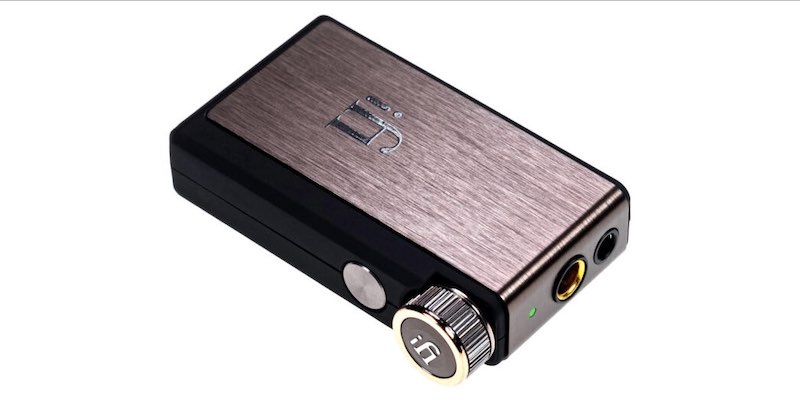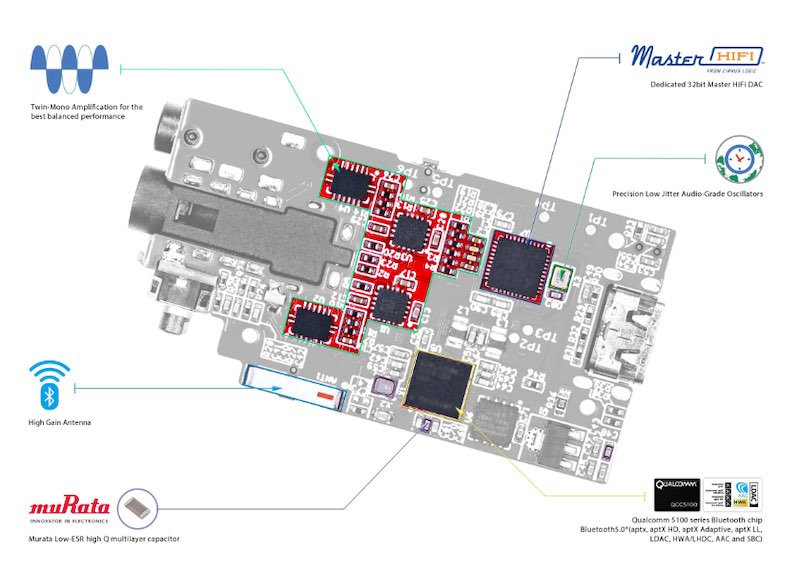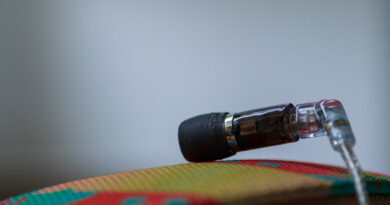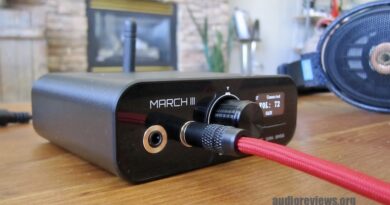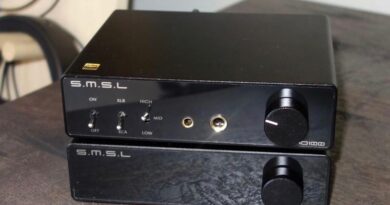iFi GO Blu Review – Sorprendentemente Bene
GO Blu is iFi’s entry-level DAC-AMP, primarly focused on Bluetooth connectivity, high miniaturisation and straightforward operation. It retails for just below 200€ and I got a temporary loan unit for review purposes which I analysed for quite an extended time. Here’s my report.
In this Article
At-a-glance Card
| PROs | CONs |
| Outstanding DAC reconstruction quality | Unimpressive Single Ended output |
| Very good Balanced output amping extension, dynamics, power, clarity | Balanced output hiss on very low impedance loads |
| Outstanding BT implementation | Limited digital input options |
| USB connectivity option as a plus | Limited package options |
| Nice volume+gain control implementation | |
| XBASS and XSPACE extra options | |
| Selectable reconstruction filter | |
| Upgradeable firmware | |
| Doubles as a good handsfree office communication device |
Features and description
Externals
The Go Blu is a minuscle device, approximately the size of a 9V battery but much lighter in weight (just 26g).
It carries an on-off button, an options button, and a volume knob which also has a button as its central part.
Phone outs, and a status LED are on the top side of the device. On the bottom there is the USB-C port, the microphone hole, the power LED, and a futher pin hole for hard reset.
The accessories package is quite limited: GO Blu comes with just a short USB-A/USB-C cable and a soft carry pouch. No USB-C/USB-C cable, let alone Apple cable are included, nor – oddly enough – a shirt clip is bundled inside the box.
Internals
Unlike so many competitive alternatives on the market, GO Blu is not designed around one of those “single chip does it all” items, but is rather a fully articulated dac-amp device, with separate communication, dac and amp sections, just “miniaturised” to fit an extremely small and lightweight footprint.
Connectivity is assigned to Qualcomm’s QCC5100 chip, the latest or one of the latest releases in its class by the wireless techology leader. The DAC section is centered on a 32-bit Cirrus CS43131 chip, sided by a separate hi quality precision clock. The amp section follows a full dual-mono design, and exploits some iFi proprietary technology called “Direct Drive” whereby they avoid using output coupling capacitors to get an even cleaner result on even other conditions.
Input specs are quite limited in terms of accepted formats: just PCM and only until 24bit / 96KHz. No higher res PCM. No native DSD. No MQA. The meta-message by iFi is quite evident here: focus on doing less, at higher quality.
Output specs (find them all here) are quite impressive: up to 5.6V @ 600ohm load on balanced output (half of that on single ended) and a promising 245mW @ 32ohm load on the opposite end (always on BE). Output impedance is below 1 ohm on both ports.
There’s a 6dB gain which is applied “automatically” as volume goes up – read more under Volume Control, here below.
The on-board battery while small features 450mAh capacity, and offered me – based on my typically low-ish playback volume, and always top-rank digital resolution – around 9-10 hours of operation.
Input
GO Blu is mainly conceived as a BT DAC-AMP device, and BT performance is in facts ace both in terms of features and results. The pairing process is straightforward and I had no problem with any of my owned devices (phones, computers).
GO Blu supports BT 5.1, and a whopping array of different codecs including AAC, AptX (Adaptive, HD and Low Latency), LDAC and LHDC/HWA. The LDAC/96 implementation in particular is very solid and – when paired to another known-good-LDAC capable device – I was able to get at least 10 meters away on open path, or 7-8 meters with 2 walls in the middle, with zero dropouts.
The USB-C port on the bottom of GO Blu main body can be also used as a digital input. Again, connectivity proved straightforward both when attached to my PC (directly, and via the Nano iUSB) or to my Android devices – on which I use 3rd party sw players e.g. UAPP and Roon.
Didn’t try Apple ecosystem devices, which are declared as fully supported nonetheless.
Existing connectivity type will take priority: if GO Blu is connected somewhere via BT, a subsequently established USB connection will “not to work” – and similarly, if I have GO Blu on BT pairing mode, but not yet BT-connected to anything, plugging it into a USB data source will kill the BT pairing process, which will not resume for as long as the USB link stays on.
Finally, GO Blu has a very good working microphone on its bottom, which is straightforwardly used for calls and phone assistant interaction. The mic quality is above average at the very least, and Qualcomm’s built-in ANC works a charm: I could use it as an office tool for a while with great satisfaction.
When using GO Blu as a bi-way communication device, short-pressing once on the volume knob’s central button answers the incoming call. Long-pressing ends the call, or activates the phone assistant.
Output
GO Blu comes with two phone output alternatives: a Balanced 4.4mm option and a 3.5mm Single Ended (S-Balanced, actually). The former is by all means the one to go for whenever possible – more on this later.
Neither is configurable as a pure Line Out.
Volume and gain control
The volume knob is apparently well designed and feels solid and precise. iFi is particularly proud on the Swiss tech they added on that, I got no competence to confirm or dismiss but a fact is I couldnt appreciate any audible volume unbalance above 2% or something, and I did witness supersmooth and cracklefree operation for my entire (long!) assessment period.
On the GO Blu iFi chose to integrate gain control within the volume knob excursion – they call it “automatic gain”. In a nutshell, GO Blu is offering low gain until 60% volume level, then it quickly applies a +6dB gain from there on.
In general, I’m not a high gain fan to say the least: the higher the gain, the higher the compression especially on budget (read: sub-multibuck) class devices. High gain to me can and should be used with high impedance loads only, and that’s why I don’t particularly mind having a classical separate “gain switch” for that.
On the other hand I do see the point iFi designers are making on seamlessly integrating gain and volume controls, clinging at non-specialistic users who will simply not want to care on learning why and how they should or should not engage High Gain, and just want a device that “does it right, automatically”.
What makes the equation solve correctly in GO Blu case is that that little device delivers a whopping high level of current already at low volume marks. Which means that most if not all mid & low impedance devices I connected to GO Blu went nicely loud and dynamic (!) already at moderate (way sub 50%) volume levels, thus never needing to engage the High Gain mode. Plugging my HD600 required a deeper volume knob excursion, and -correctly- ended up into +6dB gain territory. Good job!
Other features
Software and Firmware
Like all iFi devices GO Blu allows for easy user-operated firmware flashing. In this specific case, operations can exclusively carried out from an Anroid host though, so be aware!
There’s currently only one GO Blu firmware version available, released last January 2022 – which must be flashed in should the device come with an earlier version as previous one(s) were, frankly, buggy as hell.
On the other hand, iFi offers no host software to remote-control / remote-configure GO Blu. Nothing in the line of what E1DA does for 9038x, or Fiio for BTRx, etc is available. Too bad.
Alternative reconstruction filters
GO Blu firmware includes a sort of “easter-egg”, allowing the user to switch onto an alternative DAC reconstruction filter by following an undocumented button-pressing sequence.
To access such feature one needs to turn on and connect Go Blu (BT or wired, doesn’t matter), then triple-short-press the Power Button. At this point, single short-pressing the Options button (the one below the Volume knob) will toggle between two DAC filter alternatives:
- Minimum phase filter (upper LED turns Purple)
- Standard filter (upper LED turns Green)
The setting is saved, and will resist powering the GO Blu down.
XBASS and XSPACE
On the GO Blu too iFi added two of their most appreciated “extras”, namely XBASS and XSPACE.
Both implemented on the time domain – i.e. on the already calculated analog output coming off the DAC – for superior quality results, XBASS is a bass/sub-bass enhancer, i.e. a filter enhancing all bass frequencies without impacting on the rest of the presentation, while XSPACE is a crossfeed filter, i.e. a system whereby, vulgarly speaking, “a bit” of the left channel sound will be hearable on your right channel too, and viceversa, which brings the headphone/earphone listening experience closer to that of full size speakers of course.
Both are great to have – especially on such a modest budget device – and being a late-50ies / 60ies acoustic jazz lover I’m especially fond of XSPACE, which “magically” compensates on many of those early stereo hard-panned masters with John Coltrane “fully stuck to the left”, for example, making them even more enjoyable.
To activate XBASS and/or XSPACE all it takes is to cycle-press the options button on the right side of the device, just below the volume knob. 1 press = XBASS, 2 presses = XSPACE, 3 presses = both, 4 presses = reset to none. The options led on top, near the 4.4 port, will light of a different color accordingly.
Sound
GO Blu sounds seriously well.
The presentation range is very well extended both down low and up high, notes have very good body accross the board, and a particular mention is deserved by bass being very controlled. Highmids come accross a tad too evident, on the other end. Trebles are way airier than one may expect from such a small – therefore necessarily hw-limited – device. Perhaps most importantly, instrument separation and microdynamics are nothing short of outstanding.
Comparing by memory (I sold my unit quite some months ago) with an overall similar-featured device, GO Blu sounds significantly better than Fiio BTR5 for example : definitely cleaner, more extended, more macro and micro-dynamical.
Comparing instead with a different-featured but similarly priced device by the same manufacturer, GO Blu’s presentation is not the same as Hip-Dac – the latter is warmer down low, and less hot up high – although the “general sound quality” impression I can get from either is definitely on the same league.
As for probably 95% of sub-1K$ devices I auditioned to date, on Go Blu too single-ended output delivers much lesser quality than the balanced option next to it. Simply put, I would recommend Go Blu for Balanced only – and skip it if your main drivers are all single-ended and you don’t want to (or can!) plan on swapping cables.
Some caveats now.
One: In spite of a quite low output impedance (below 1 ohm), GO Blu’s Balanced output produces significant hiss on very low impedance + high sensitivity loads (Andromeda and such).
Two: GO Blu’s USB connection does and will charge the battery while playing, when connected to a host providing power on the VBUS wire. As a consequence, USB-connecting GO Blu directly to my PC produces audibly worse (closer, more compressed, less dynamical) output compared to connecting it through my Nano iUSB3, or to a battery-powered pure transport (eg a Tempotec V1).
Some educational pairings
Final E3000
I would call this an unreal pair in terms of amping authority, if it weren’t for the fact that E3000’s fixed cabling forces me into the Single Ended option on the GO Blu, and sadly it shows. With that being said, GO Blu’s amping module makes E3000 open up and sing quite well, so much as to make the pair an incredibly good “compromise option” e.g. when adopting GO Blu as a BT device and mid-fi digital sources e.g Spotify or similar.
Final E5000
Not the best pair in the world at all for those but waaaay better than so many alternatives. E5000 is the empyric proof, if one is ever needed, of how vivid current GO Blu outputs already at very low volume positions, making E5000’s bass not “melting” into a too dark presentation as on most other lowcost stuff I heard it on. Very well done here.
Sennheiser HD600
GO Blu drives HD600 with great authority powerwise, even from the single ended out which is the sole I could test as I don’t care putting a balanced cable on my HD600, Groove pair being endgame for those at my place. GO Blu’s “automatic gain” works greatly here.
Considerations & conclusions
The main thing about GO Blu is that, quite simply, it sounds surprisingly good – especially so via its Balanced Ended output, which is the part I would recommend it for anytime really.
This little kid impressed me quite a lot for its very good DAC reconstruction quality, its more than decently clean amping stage, its capacity to drive low impedance and high impedance loads equally well, and the incredible life it delivers to most of my drivers.
Weren’t this enough add supersolid BT 5.1 (!) connectivity, XBASS and (to me, especially) XSPACE, and great performance for office calls, too.
What else can one want? The man on the road would probably, and justly, respond “nothing, just take my money now”.
I’m an old grumpy fellow so I always go around looking for flipsides, and GO Blu does have a few of course too: Single Ended output quality is rather unimpressive for one; output power although good is not enough for planars and such; Balanced output hisses off on very low impedance loads; well… that’s it really.
Also due to some unwanted external interferences I got in the past months, I took my sweet time assessing this device and I feel I need to particularly thank iFi Audio for the patience they had after supplying my loaner review unit back last december already!

